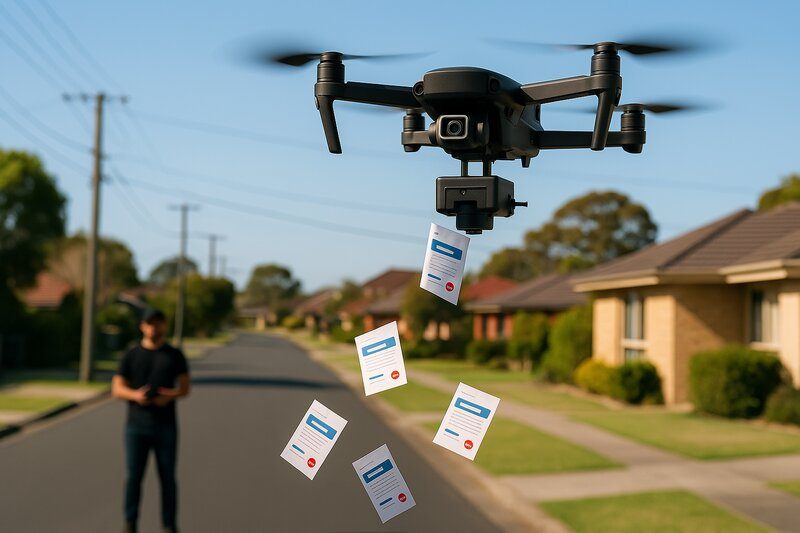Dropping from a Drone: How to Stay Legal in Australia (2025 Guide)
Introduction
Discharging, dispensing or dropping from a drone in Australia is a serious matter — and it’s tightly regulated by CASA (Civil Aviation Safety Authority). If you’re considering dropping from a drone, whether it’s leaflets, safety gear, promotional items, or agricultural products, you must follow strict legal requirements.
Flying Glass offers consultancy services to help you gain CASA approval for dropping, discharging, and dispensing operations.
This guide explains everything you need to know about drone payload deployment in Australia, including rules, risks, and how to do it the right way.

Understanding Dropping, Discharging, and Dispensing from a Drone
CASA defines these activities as:
- Dropping: Releasing an object from a drone during flight.
- Discharging: Ejecting or spraying substances (e.g., chemicals, liquids).
- Dispensing: Releasing any material (solid, liquid, gas) while airborne.
All these operations fall under CASR Part 138 and carry strict safety, legal, and operational requirements.
Important: Without specific CASA authorisation, dropping from a drone is illegal.
CASA Rules for Dropping, Discharging, and Dispensing Operations
Australia’s dropping from a drone laws are covered under:
- CASR Part 138 (Aerial Work Operations)
Key CASA Requirements:
- Aerial Work Certificate: Required for most aerial work, including dropping or dispensing operations.
- Manual of Standards (MOS) Compliance: Operators must meet MOS standards for dispensing.
- Risk Assessment: Detailed risk assessments are mandatory.
- Operating Procedures: Specific procedures must be included in your operations manual.
- CASA Approval: Must be granted before conducting any dispensing flight.
Failure to comply could result in strict liability offences, with large penalties per breach.
No Exceptions: Flying Over People Requires OONP Approval
Flying a drone over or near people is never allowed under standard rules — unless you have a CASA-issued OONP exemption. OONP stands for Operations Over or Near People, and it’s one of the most tightly regulated aspects of Australian drone law.
If your drone will be above any person (whether they’re involved in your operation or not), you must secure this special approval beforehand. CASA’s Part 101 rules explicitly prohibit flying over people without a specific instrument of approval and additional safety measures (such as a certified parachute system) in place. Without an OONP authorisation, even an accidental fly-over can land you in serious trouble.
No loopholes exist for this rule. It doesn’t matter if the people below are inside a vehicle or under shelter — they still count. Consent doesn’t change it either; even if bystanders agree or are part of the project, the law remains the same.
That means no dropping from a drone, discharging, or dispensing operations can occur over people unless you hold an OONP approval. If there are people under your drop zone (or likely to wander nearby), you are legally required to have the OONP exemption — no exceptions.
In fact, CASA also bans releasing any object from a drone if it could create a hazard to another aircraft, person, or property. So if your planned drop might endanger someone below, it’s automatically off-limits without special clearance. OONP approval goes hand-in-hand with rigorous safety planning (like using parachute recovery systems on the drone) to ensure that even if something goes wrong, people remain protected.
Simply put, if people are anywhere in the vicinity of your drone operation, you need CASA’s permission to fly over them — especially when you’re carrying and releasing a payload.
Ready to fly safe and legal? Make sure you’re covered. Check out our comprehensive OONP guide for a deeper dive into obtaining this CASA approval. With our experience as one of Australia’s first OONP-approved operators, we’ll guide you through the process so you can conduct dropping from a drone and deliveries confidently and compliantly.
Use Cases for Dropping from a Drone
While risks are high, there are legitimate and useful reasons to deploy items from a drone.
1. Leaflet Drops
- Promotional flyers for events.
- Political campaign material.
- Awareness campaigns.
Note: Even harmless paper leaflets can cause hazards (e.g., startle people, litter public spaces), requiring CASA and local council approvals.
2. Emergency Equipment Drops
- Lifejackets, emergency kits to people stranded in remote areas.
- First-aid supplies during search and rescue missions.
3. Agricultural Applications
- Seeding operations.
- Controlled chemical or pesticide dispensing (strict chemical licences required).
4. Promotional Events
- Dropping confetti, fake snow, or other event materials.
5. Scientific and Environmental Research
- Deploying sensors or trackers in hard-to-reach areas.
Every use case needs a tailored safety plan and appropriate CASA permission.
Why Dropping from a Drone is Regulated
- Risk to People: Even lightweight objects can cause injuries.
- Risk to Property: Falling items can damage cars, homes, or infrastructure.
- Airspace Safety: Uncontrolled drops could interfere with manned aircraft.
- Environmental Protection: Chemical discharges need strict local and national controls.
CASA takes these risks seriously — which is why operations involving dropping from a drone, discharging, and dispensing are carefully monitored.
How to Legally Drop Items from a Drone
- Obtain an Aerial Work Certificate
- Create a Full Operations Manual
- Conduct a Risk Assessment
- Prepare a Dispensing Operation Plan
- Seek CASA Approval
- Obtain OONP Approval
- Get Local Council Approvals
- Supervised Flight Experience
Flying Glass can guide you through this process or perform the flight legally under our existing certifications.
Risks of Non-Compliance
Attempting to drop or dispense without CASA approval can lead to:
- Fines of up to $10,000+.
- Loss of RePL (Remote Pilot Licence).
- Suspension or cancellation of ReOC (Operator’s Certificate).
- Public liability lawsuits if injury or damage occurs.
- Criminal charges in extreme cases.
Do not risk your business, reputation, or safety. Always work with professionals.
Drone Payload Release Systems
Payload release mechanisms are small devices attached to drones, allowing remote dropping of:
- Packages
- Life-saving equipment
- Survey devices
Popular systems include:
- Servo motor-based hooks
- Electromagnetic payload releases
- GPS-triggered release mechanisms
All systems must be assessed for safety and approved by CASA before operational use.
Flying Glass Consultancy Services
Flying Glass can help you legally achieve your payload deployment goals. We offer:
- CASA Consultancy: We prepare your applications, risk assessments, and flight plans.
- Operations Manual Support: Craft procedures that meet CASA requirements.
- OONP Approvals: Assistance obtaining OONP approvals for flying over or near people.
- Payload Equipment Advice: Help sourcing approved payload release systems.
- Professional Drone Operations: Hire us to help with your drone operation.
Ready to deploy safely? Contact Flying Glass today for expert help with CASA approvals and payload operations.
FAQs: Dropping from a Drone
Is it legal to drop something from a drone in Australia?
Only with CASA approval and strict safety protocols in place.
What approvals do I need?
You need CASA approval under Part 138 and an OONP approval if flying over people.
Can I leaflet bomb from a drone?
No, not without specific CASA and local council approvals.
What happens if I drop something illegally from my drone?
You risk major fines, licence suspension, and possible criminal charges.
How can Flying Glass help?
We provide consultancy services to help you legally plan and execute drone dropping operations.
Final Thoughts: Dropping from a Drone in Australia
Dropping, discharging, or dispensing from a drone is a powerful but highly regulated capability. Whether you’re planning a leaflet drop, an emergency equipment deployment, or an agricultural operation, you must operate legally under CASA regulations.
Flying Glass offers expert CASA consultancy services to help you navigate the complexities of aerial work approvals, including OONP approvals. Or, if you prefer, we can carry out the operation for you safely and legally.
Ready to deploy with confidence? Contact Flying Glass today to start your CASA approval process or book a professional drone operation.

